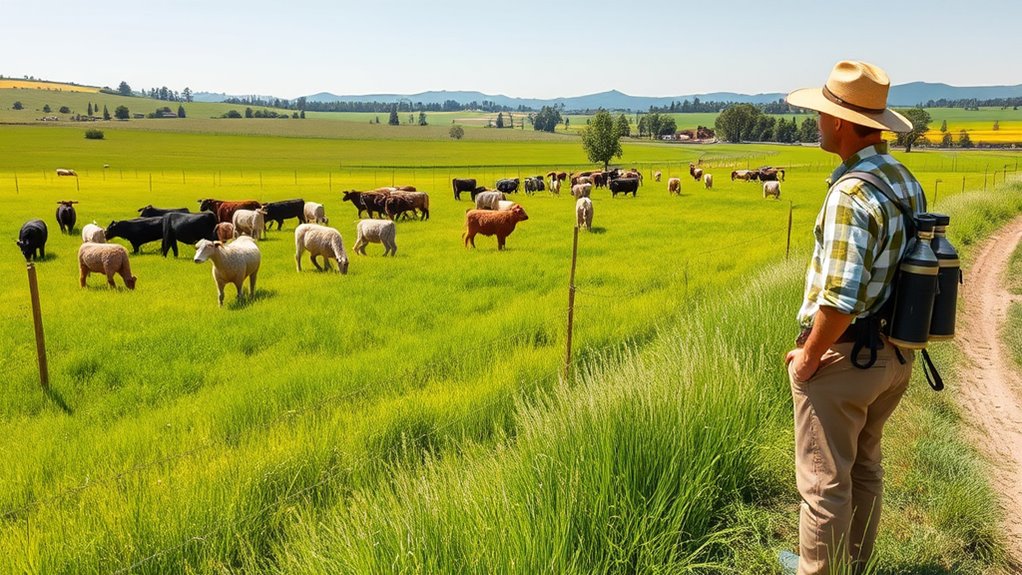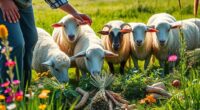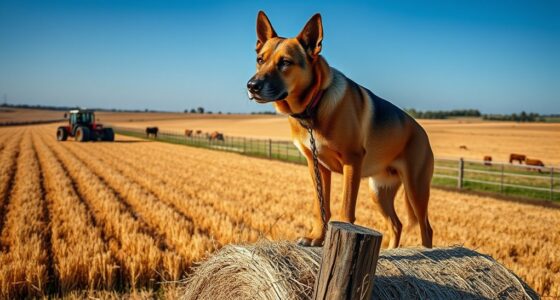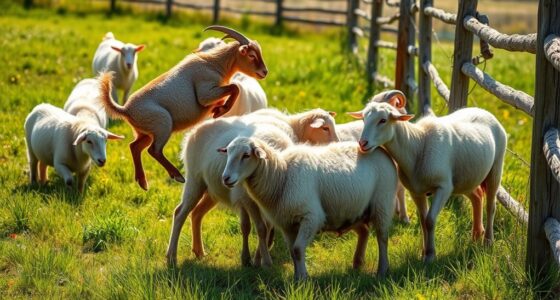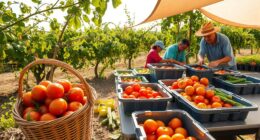Implementing rotational grazing strategies for mixed livestock involves moving animals between paddocks to prevent overgrazing and promote soil recovery. You’ll want to monitor pasture health regularly, adjusting grazing and rest periods based on plant regrowth and soil moisture. Encouraging a diverse mix of grasses, legumes, and forbs enhances ecosystem resilience and forage quality. Proper manure distribution naturally fertilizes the land, supporting long-term pasture productivity. Continue exploring these techniques to optimize your grazing system’s sustainability and success.
Key Takeaways
- Implement flexible grazing schedules that allocate appropriate rest periods for different livestock species and pasture conditions.
- Monitor pasture health regularly to adjust grazing intensity and prevent overgrazing or soil compaction.
- Rotate livestock between paddocks to evenly distribute manure, enhance soil fertility, and promote diverse plant growth.
- Incorporate varied plant species to improve pasture resilience, nutritional value, and support ecosystem diversity.
- Use strategic livestock movement to maintain balanced grazing, optimize pasture recovery, and sustain long-term productivity.

Rotational grazing strategies are highly effective for maintaining healthy pastures and maximizing livestock productivity. When you adopt a rotational system, you give each pasture section time to recover before grazing again, which directly benefits your soil health. Healthy soil is the foundation of a productive pasture, and by rotating livestock across different paddocks, you prevent overgrazing and soil compaction, which can degrade soil structure and reduce nutrient availability. This approach helps maintain the natural balance of microorganisms and organic matter in the soil, leading to better water retention, nutrient cycling, and root growth. This cycle not only improves pasture productivity but also promotes a more diverse plant community, which, in turn, supports soil health. Online banking services are available 24/7, making it easier to plan and monitor your grazing schedules remotely.
In addition to improving soil health, rotational grazing encourages pasture diversity, which is essential for creating a resilient and sustainable grazing system. By moving livestock frequently, you promote a variety of plant species, including grasses, legumes, and forbs, which thrive under different grazing pressures. This diversity not only enhances the nutritional value of your forage but also creates a more resilient ecosystem. Diverse pastures are better at resisting pests, diseases, and drought conditions because different plants have varying tolerances and growth patterns. You’ll notice that with increased pasture diversity, your livestock can access a broader range of nutrients, leading to improved health and productivity.
Implementing a rotational grazing system requires planning and flexibility. You’ll want to monitor pasture condition regularly, noting plant regrowth and soil moisture levels to determine the ideal grazing and rest periods. By adjusting the timing, you prevent overgrazing in any one area and give plants time to recover and regrow vigorously. This cycle not only improves pasture productivity but also promotes a more diverse plant community, which, in turn, supports soil health.
Furthermore, rotational grazing allows you to manage manure distribution more evenly across your land. As your livestock move through paddocks, their manure acts as a natural fertilizer, enriching the soil and promoting plant growth. This symbiotic relationship helps build a healthy soil ecosystem and reduces the need for chemical fertilizers. Over time, this holistic approach creates a sustainable, productive pasture system that benefits both your livestock and your land.
Frequently Asked Questions
How Do I Determine the Optimal Grazing Rotation Length?
To determine the ideal grazing rotation length, observe your pasture’s growth rate and plant recovery needs. You should aim for a grazing cycle that allows enough pasture rest so plants can recover and maintain healthy growth. Typically, this cycle lasts between 15 to 30 days, but it varies based on forage type, weather, and livestock pressure. Monitor pasture conditions regularly and adjust your rotation to prevent overgrazing and promote sustainability.
What Are the Costs Associated With Implementing Rotational Grazing?
Implementing rotational grazing involves costs like a thorough cost analysis of infrastructure investments, such as fencing, water systems, and gates. You’ll need to budget for initial setup and ongoing maintenance, which can be significant depending on your farm size. While these expenses can be high upfront, they often lead to long-term savings through improved pasture health and livestock productivity, making the investment worthwhile over time.
How Does Rotational Grazing Impact Soil Health Over Time?
Rotational grazing improves soil health by boosting soil fertility and increasing microbial diversity. As you rotate livestock, you allow pasture plants to recover, which enhances organic matter and nutrient cycling. This process promotes healthier roots, stronger plant growth, and richer microbial communities. Over time, these changes lead to more resilient soil structure, better water retention, and sustained productivity, ensuring your land stays fertile and vibrant for future grazing seasons.
Can Rotational Grazing Be Combined With Other Pasture Management Techniques?
Yes, you can combine rotational grazing with other pasture management techniques. For example, integrating pest control methods helps keep pests in check, while biodiversity enhancement encourages diverse plant growth. These combined strategies improve pasture resilience, boost forage quality, and support healthier livestock. By actively managing your pasture with multiple techniques, you create a sustainable system that benefits both your land and animals, leading to long-term productivity.
What Are Common Challenges Faced When Managing Mixed Livestock?
Like balancing a delicate dance, managing mixed livestock requires careful attention to species compatibility and water resource management. You often face challenges in ensuring different animals coexist peacefully and share resources without conflict. You need to monitor their grazing patterns, prevent overuse of water sources, and adapt to seasonal changes. By keeping a close eye on these factors, you can maintain a harmonious environment that supports healthy, productive animals.
Conclusion
Imagine your pasture as a well-choreographed dance floor, where each move keeps the grass healthy and your livestock happy. I once saw a farmer increase his herd’s productivity by rotating grazing every few days, giving plants time to recover. Just like a well-timed dance, rotational grazing keeps the land vibrant and sustainable. Embrace these strategies, and you’ll find your farm flourishing—healthy pastures today, productive herds tomorrow.

